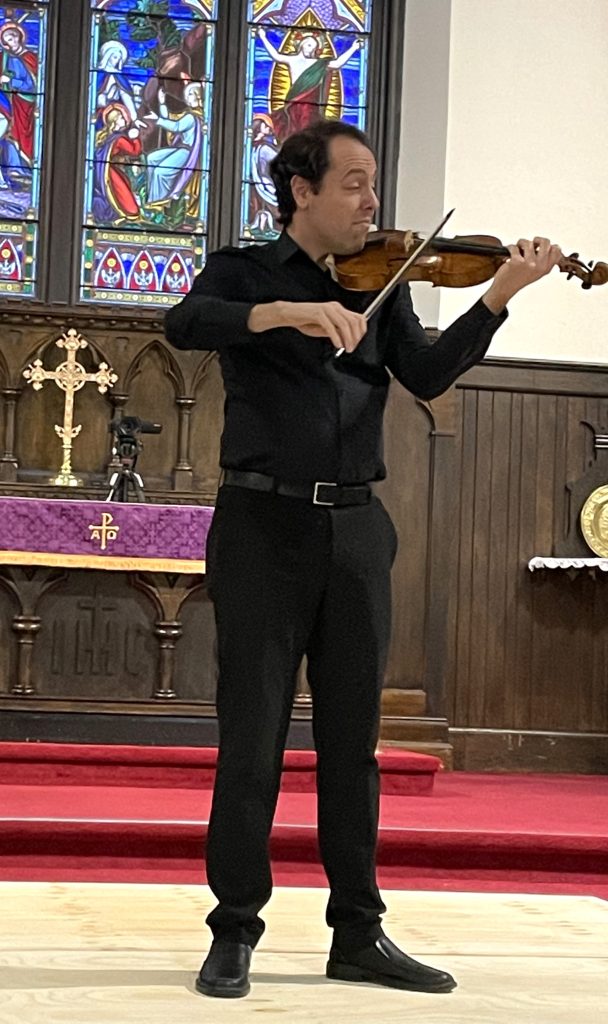
Veiled by a long curtain of rain posing as the herald of Spring, noted violinist Edson Scheid performed Johann Sebastian Bach’s Partita no. 2 in D minor, BWV 1004 (c. 1719) at Trinity Episcopal Church in Lakeville, CT this past Saturday. This famous work offers examples of four dances along with commentary and critique by Bach on their dance platform.
Scheid played a period Baroque violin which has a higher pitch than a contemporary violin; also, a more mellow sound in the lower register. This Partita is often merely called the Chaconne by violinists who value this work as perhaps the most transcendent violin piece ever composed.
Opening with the duple meter of the Allemanda, a two-step German dance the work offers a subtle critique: this dance and rhythm remains too simple to give real pleasure. Likewise, the French Corrente bestows a formality of manners and dull ceremony that dismisses spontaneity in the dance. I thought Schied’s interpretation of these two dance motifs were rather post-modern—that these dances were abstract historical artifacts capable of unusual sound resonances and that the better approach was to value sound as not relative to the dance meters.

Both for Bach and Schied, the Sarabanda was more lively, interesting, complicated, and exultant with rapid meter. For both Bach and Schied this was relevant to the present with the excitement that the now demands. For Bach the Celtic Giga was even better because the dance offered more freedom of movement, more spontaneity and improvisation—in short, a more complete exercise of personal freedom and humor; for Schied the jig appeared too-elementally-primitive and irrelevant to the present—the jig being an archaic relic of pop culture.
The last movement, the Chaconne (or Ciaccona), offers the player the opportunity to create and improvise new formulation-interpretations and improvisations that combine elements of these four dances as the music operates like a giant jigsaw puzzle juggling various meters like a magician, which permits any player to infuse singular emphasis, which in Scheid’s interpretation was the higher-pitched transcendence of the ineffable that a Baroque period violin can offer.

After intermission Schied played seven of Nicollò Paganini’s 24 Caprices (showcase pieces written between 1802-1817). Scheid has recorded all 24 on a single Naxos recording. (A recording of this whole concert was being done in the Church which has wonderful acoustics.)
No. 1, the opening Andante was a genial introduction and invitation. I like to label descriptive tags on each movement. No. 2, Moderato, offered the polite argument of the courtroom before a judge. No. 13 provided ridicule of the pretentious pomp and majesty of royal courts. No. 14, Moderato, depicts a scenic Spring stroll though the wonders of a rural landscape. No. 5, Agitato, portrays the turbulence and anguish of unconsummated love. No. 11, Andante-Presto, depicts a father denying his very young daughter something she badly wishes, and the following Presto is her wounded, cute, and tearful appeal, which is successful. No. 24 depicts the variations of weather from heavy clouds to rain to clouds while concluding with a celebration of sunlit days. For the “rain” plucking Scheid’s resonance and rhythms were memorably climatic.
Scheid played everything from memory without sheet music. Despite the rain rattling down, the Church was oblivious to the element and not a raindrop was heard, but the sound of the violin breathed witty, eloquent clarity and transparent purity.

P.S. Paganini was forbidden a Christian burial in Genoa (his birthplace) by the Pope because Nicollò refused the offer of a priest to make a deathbed confession of sins—and so he was buried on his own property. In Italian pagan means a peasant who has not heard of Christianity; ni means born of. Paganini means neither ancestral fore-bearers were Christians.